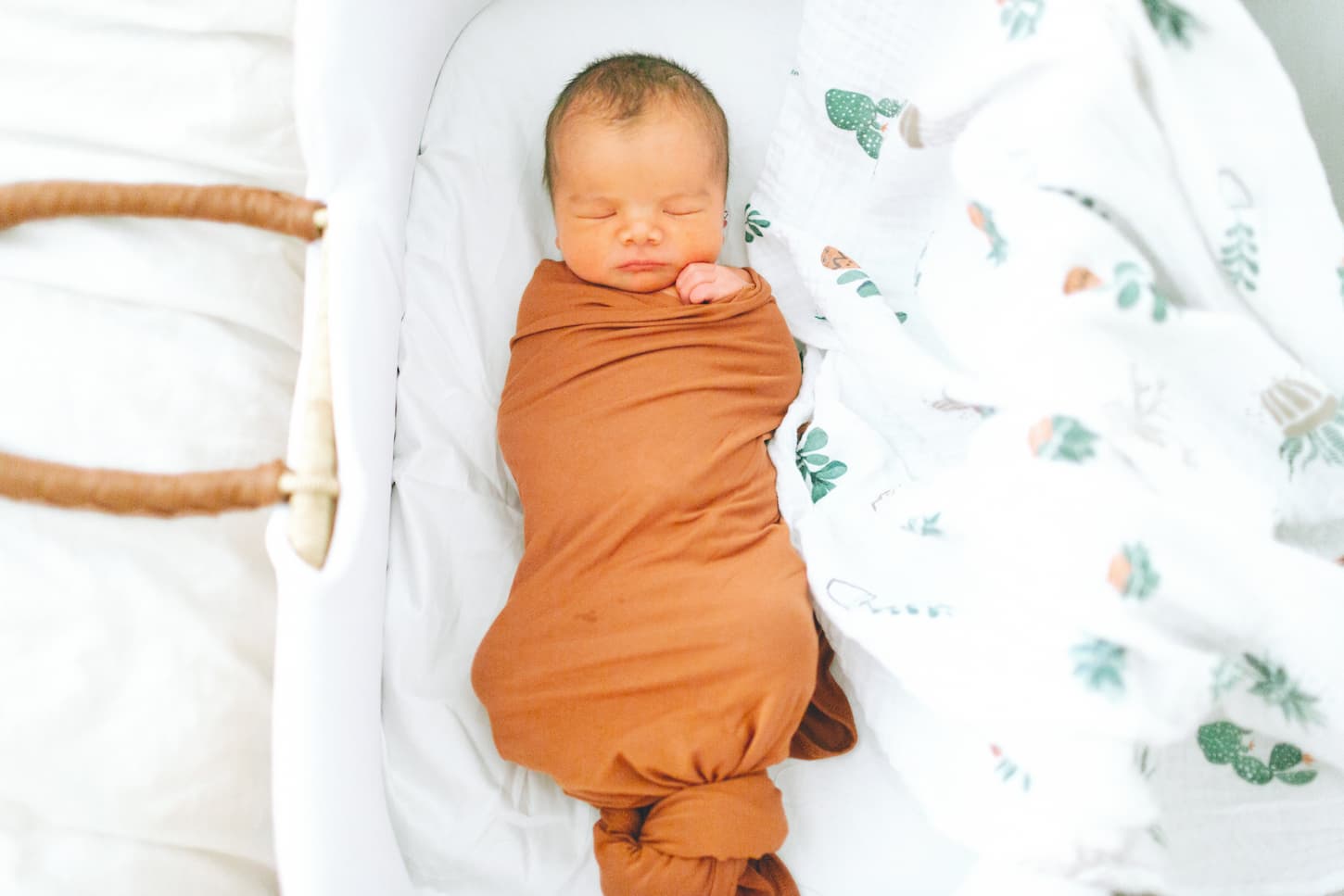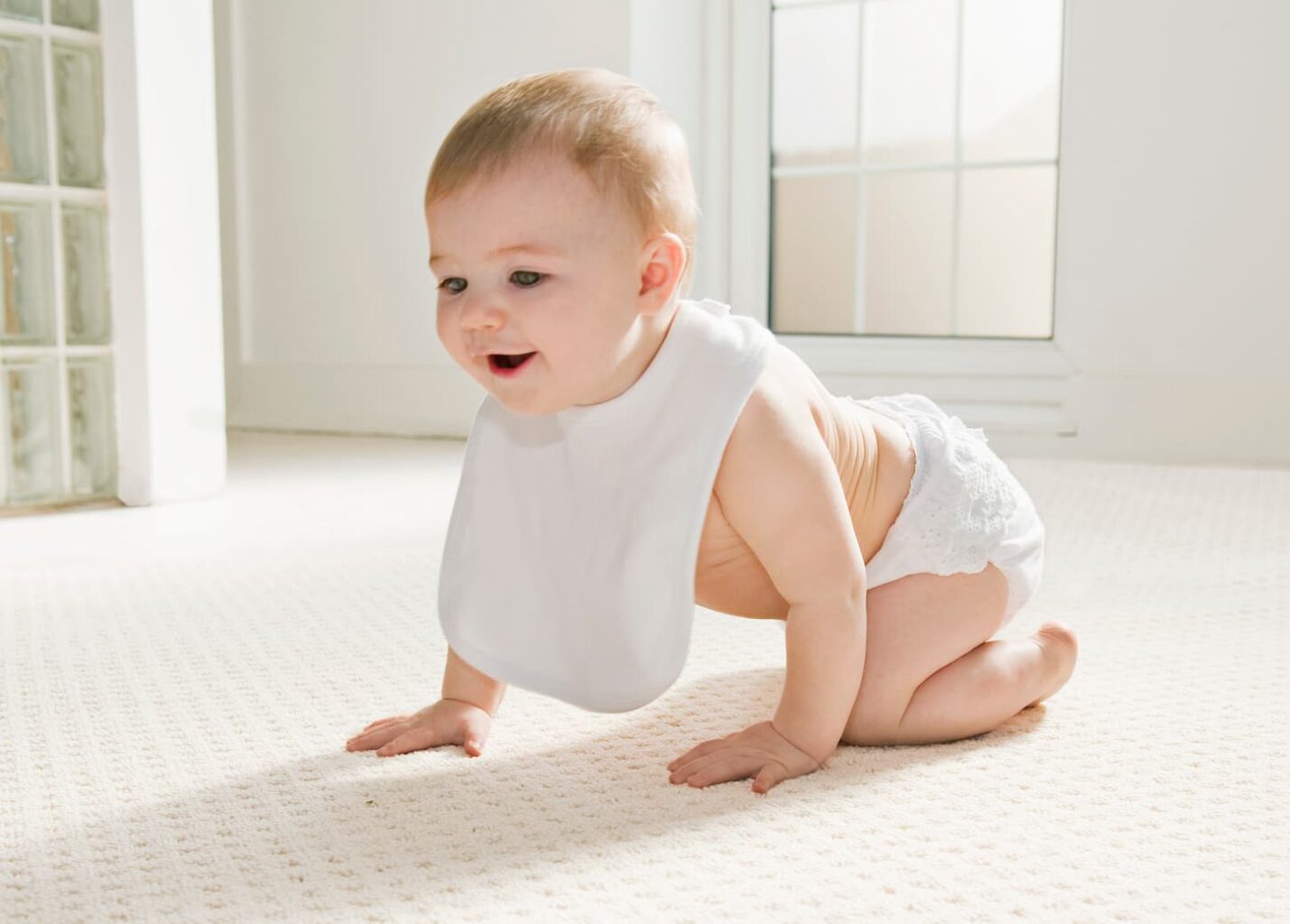After the first two weeks of sleep training our baby, we were crestfallen to discover that things weren’t 100% “fixed.” Our baby still had sleep issues, we were still exhausted, and we weren’t sure if things would ever get better. So what can you do if, after two weeks, sleep training doesn’t seem to be working?
Many families will need to consistently sleep train for a month or more before seeing discernible or lasting results. Most families may see an initial improvement in those first two weeks, but sleep training can end up being a process that continues over the course of a year or more.
In other words, two weeks may just not be long enough of a sleep training session for your child. If it is, don’t stress – it wasn’t for us, either. So let’s dive into what you can (and can’t) do if things aren’t improving rapidly enough for you within that two-week time frame.

What to Do When Sleep Training Doesn’t Happen in 2 Weeks
So many sleep training methods and plans say that they’ll always work within two weeks. But the truth of statistics, bell curves, and my own experience tell us that a guarantee like that is going to see exceptions to the rule. Not every sleep training plan will work for every single family.
So here’s what you need to do when you realize that your current sleep training methodology hasn’t worked within two weeks.
Admit that you aren’t where you wanted to be. The only way we’re going to reach our goal is by admitting that what we’re doing isn’t working – and then changing it to something else (that will hopefully work better than what we have been doing).
Know the law of averages. If a sleep training plan works for most people for two weeks, know that it won’t work for other people within that same timeframe. It could still work – but it could take a lot more time. Or you and your baby may need a different methodology.
Have a learning or growth mindset. You may not have solved the sleep problem yet, but you did find something that didn’t work. See what you can change to find something that works better. Then, find what works best. Keep going – until you can say that you have solved the sleep issues in your home.
Evaluate what has worked. If your current plan is seeing baby steps of progress, then that’s awesome. Your child might be a stubborn one (like mine is) that needs more than two weeks to adjust to the new normal of actually sleeping.
Determine what didn’t work. If your plan is causing more stress and less sleep, then find what didn’t work. It may be time to change the methods used or even quit entirely. Quitting could be temporary or permanent – but read my article on when to quit sleep training for more details.
Modify the sleep training plan (if needed). Look at what works (and what doesn’t), then determine if you need to change your current plan. Then, plan those changes.
Give the new plan a chance to succeed. Once you implement your new plan, give it at least a couple of weeks to see if it’s working. Or, if it’s also a total failure, restart this evaluation process to see where else you can tweak things.
Evaluate and modify as needed. Seriously – for some of us, sleep training wasn’t a one-time, two-week thing. It can take months and years for some children. That’s not weird or abnormal – it just is.
Be patient with yourself and your child. Doing anything while exhausted is hard. And right now, you’re all exhausted. So take a deep breath. You can do this. Just take one step at a time.
Of all of those steps, there isn’t a most or least important one. They all play into this, so make sure you didn’t skip any. I know how easy it is to skim-read when you’re tired!

Some Babies Need More than 2 Weeks to Sleep Train
While that headline above says it all, let’s still go into it a little more, especially as to the why. Why is it that some babies need more than two weeks to sleep train?
To date, there are exactly zero scholarly studies on how long it takes to sleep train a child. ZERO. There aren’t even some less-than-scholarly studies detailing how long it takes to sleep train. The closest thing we have are some smaller surveys (usually done in a heavily biased environment) that ask parents to self-report on sleep training results.
And while that gives us a good starting point for data, I used the words “biased” because the results are going to be skewed. Here’s what I mean.
- If only I ask a group of parents with children who are naturally easy sleepers about sleep training, then I’m going to get one group of answers. Those answers will probably show that sleep training can be done fairly quickly and easily – and without much effort.
- If I were to only ask a group of parents with colicky babies about sleep training, then I’d get a completely different answer set than the above group! These parents will probably report sleep training as being a real effort – and that it takes more time.
- Any time there’s an optional survey, there’s something called “response bias.” Most people in the middle aren’t going to respond to a survey. Instead, it’s usually those who are more emotionally invested who are going to respond. It’s like a product review. People who leave reviews are usually those who absolutely love or hate it.
So given that there aren’t a ton of unbiased studies available, I think it’s pretty reasonable to make some assumptions and conclusions about sleep training. So let’s make those conclusions together, shall we?
- Every child is different and special. They each need different amounts of time to learn and master different skills. So why shouldn’t that hold with sleep training?
- If every child could be successfully trained to sleep well within a single week, then why are there so many parents in various sleep training groups and forums reporting otherwise? (and why am I writing this article??)
- Open your favorite search engine and do a search for how long it takes to sleep train a child. Then, evaluate the source. Most sources will tell you that it only takes a week. Then consider the source. Is that source selling you something?
- Statistics and the law of averages tell us that while 85% of cases will fall within a couple of standard deviations of the “average,” there are still outliers. Translation: if 85% of the kids can sleep train within a week or two, that means 15% of kids won’t sleep train within two weeks.
Okay – that’s enough statistics and science for now. Suffice it to say that not every child will sleep train within a couple of weeks. For some of us, it takes a lot longer.
Our kids aren’t easy sleepers. They required sleep training – and dedicated, intensive sleep training at that.
We did our first round of dedicated sleep training with each child at about 7 months of age. The first week usually saw a huge improvement, but things didn’t magically keep getting better. From there, we had to keep up with our sleep training regime for several months. Any time we backed off, things would get worse. Or we’d hit sleep regression and everything went haywire.
But if we stuck with our sleep training plan, then over a period of weeks and months, then our children would gradually improve as sleepers. By about a year old, our children would make a huge leap forward in their sleeping ability and we would consider things improved enough to stop the dedicated sleep training.
At that point, though, we still had to stick with the bedtime routine – or we’d fall out of our good habits and regret it after a few bad nights. Even now that our children aren’t babies anymore, we still have to occasionally supercharge our focus on bedtimes and good sleep habits.
So how long has it taken us to sleep train? Well, we’ve been sleep training each of our four children for years. The “hard part” was over within a few months, though. Today’s “sleep training” is more like practicing good sleep hygiene than anything else. And while there’s still wailing when we announce that it’s bedtime, it’s nothing like when we did cry it out. So things do get better!
Here’s How Long It Takes to Sleep Train
How long it takes a child to sleep train is going to depend on the child, the family, and all of the involved personalities.
We’ve seen our sleep training journey as a series of stages.
- The quick fix. Each of our children underwent an intense, 1-2 week sleep training “boot camp.” No babies wore boots – or did any push-ups. But each of our children (at about 7 months of age) did a dedicated, 1-2 week round of sleep training with the method that we determined best for them. Several of our kids needed multiple rounds of this before moving on to the next phases.
- The next steps. Once each child had “graduated” from the quick fix, we started working on improving other areas of their sleep, like naps. This also took several weeks or longer.
- The “patiently persevering” phase. Each of our kids needed a lot of practice at mastering their newly-learned sleep skills. They didn’t start getting “good” at sleeping until they were each at least a year old. In other words, it took us 5 months to get to this stage, which is way more than 2 weeks.
- The “bedtime is beautiful” stage. This stage is a myth for some children, although some will get here eventually. The timing at this stage is different for each child. Our oldest boy, who’s 9 years old, is amazing at bedtime. Not every night is perfect, but he’s generally fine with going to bed at a reasonable hour. He reached this stage last year. We’re still waiting on the other three to get here.
Looking at it overall, the “quick fix” stage might only take a week or two. Or it may take several months. That stage took us several months, even with our youngest children.

A Note on Sleep Training Naps Taking Longer than 2 Weeks
Does the fact that sleep training takes some families more than two weeks mean that there’s something wrong with those people? I really hope not, because we’re in that camp. But I also don’t think it does.
And as evidence, I’d like you to think about dieting for a moment. Because can everyone reach their ideal weight or a particular health goal in two weeks? Some people can – and they’re pretty amazing.
But many of us are going to need a whole lot more than two weeks to create, keep, and internalize any new health-related goal. We’re going to need months.
And guess what? Your sleep is definitely related to your health. So if your baby needs longer than two weeks to develop healthy sleep practices with your support? Don’t feel bad about it. Just keep helping and supporting them with a gentle, long-term sleep training plan.
An important note: cry-it-out-based sleep training is an amazing “quick fix” step, but it’s not designed for long-term sleep training. You can most definitely start your quick fix with cry-it-out but then transition to a gentler methodology for the next steps and the long haul.
Finally, remember that getting a good night’s sleep isn’t just a dream. It can become a reality. It just takes some of us longer to reach that reality than it does others. And that’s okay. We’ll get there.
Can a Specialized Sleep Product Help Timing Improve?
In my experience, sleep-improving products (like sleep sacks, which are amazing) can do a ton to help improve sleep training timing, but only for a short period of time.
For example, let’s look at sleep sacks and Swaddlers. Do they help your child sleep better for a while? Absolutely they do! However, your baby is going to outgrow them before too long. At best, they’ll only be helpful for a few months. But that may be all that you need.
So just know that buying some amazing sleep training enhancing product will only work for a few months. However, if you’re using it in conjunction with dedicated sleep training, then that may be more than enough to get your child on the path to a full night’s sleep.
Is buying that fancy gear worth it, then? That’s going to depend on your family, your sleep situation, your finances, and your goals.
- We used Swaddlers to help our babies sleep better until they were old enough to sleep train. It was worth it for us.
- We used sleep sacks to help our children while sleep training. They loved their sleep sacks!
- We did not invest in any fancy furniture (beyond a rocking chair). We decided that wasn’t in our family’s best interests. With our youngest, we traded in the rocking chair and invested in a recliner – and we should totally have done that earlier!
As you’re trying to decide if a particular sleep training product is worth it, evaluate it from all angles. Make sure it’s something you can afford and that it will help, even if you decide that the short-term help is worth it. Then, if you want to see the list of products that we used and recommend, make sure you check out my list of best sleep training resources and products.

Related Questions
What is Gentle Sleep Training? Gentle sleep training is a group of sleep training methods that use fewer (or no) tears as part of the sleep training plan. Read my complete guide to gentler sleep training for more information.
Is it OK to Let a 1-Year-Old Cry it Out? Research studies have shown that intentional, short-term use of crying during sleep training doesn’t have negative lasting effects. Read my article on letting your 1-year-old cry it out for more information.
What Is a Sleep Regression? Sleep regression is a non-medical term for a period of time when a child’s sleep gets worse over time. Read my article called “What is a sleep regression?” for more info.